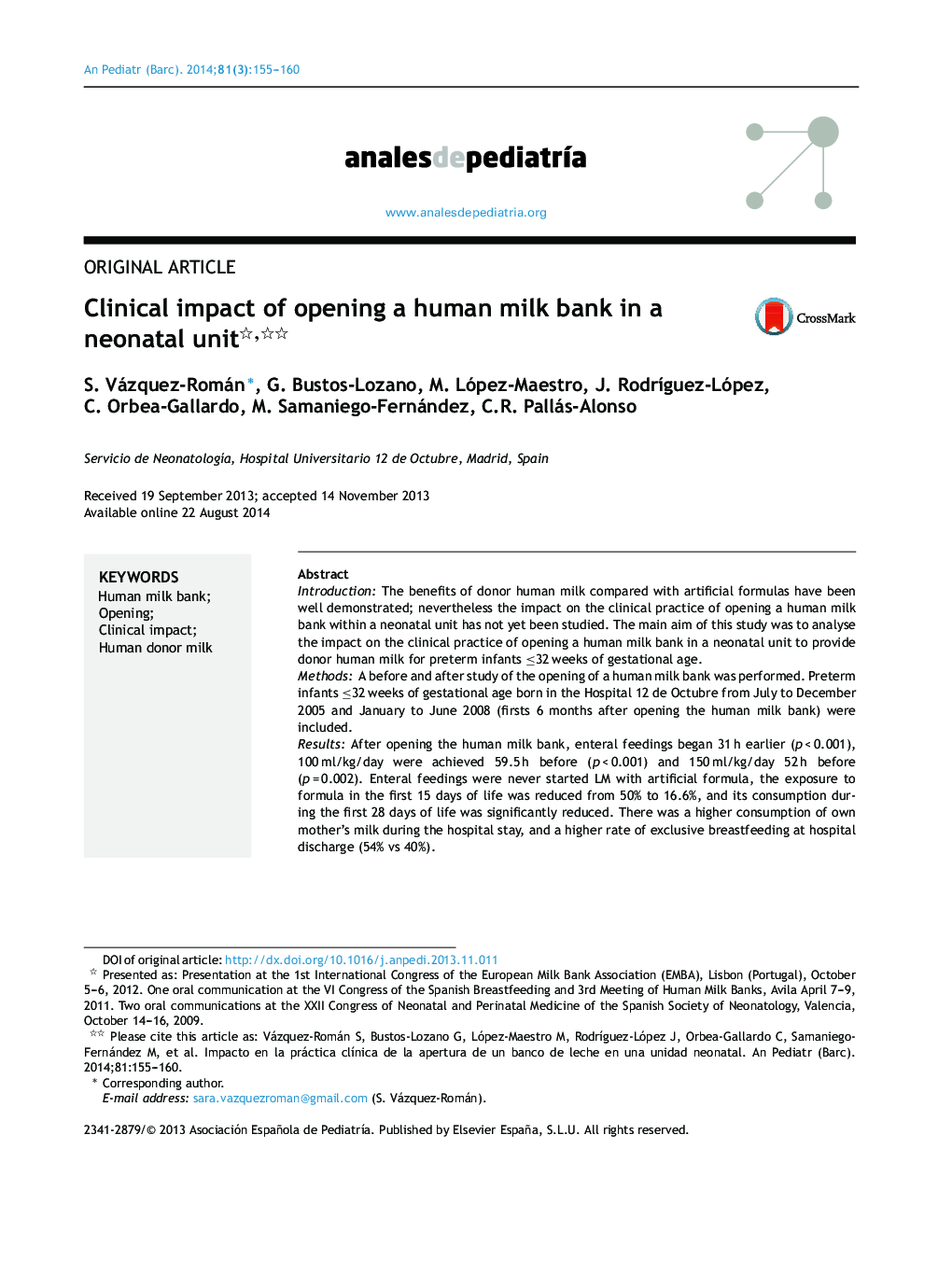| کد مقاله | کد نشریه | سال انتشار | مقاله انگلیسی | نسخه تمام متن |
|---|---|---|---|---|
| 4145293 | 1272600 | 2014 | 6 صفحه PDF | دانلود رایگان |
IntroductionThe benefits of donor human milk compared with artificial formulas have been well demonstrated; nevertheless the impact on the clinical practice of opening a human milk bank within a neonatal unit has not yet been studied. The main aim of this study was to analyse the impact on the clinical practice of opening a human milk bank in a neonatal unit to provide donor human milk for preterm infants ≤32 weeks of gestational age.MethodsA before and after study of the opening of a human milk bank was performed. Preterm infants ≤32 weeks of gestational age born in the Hospital 12 de Octubre from July to December 2005 and January to June 2008 (firsts 6 months after opening the human milk bank) were included.ResultsAfter opening the human milk bank, enteral feedings began 31 h earlier (p < 0.001), 100 ml/kg/day were achieved 59.5 h before (p < 0.001) and 150 ml/kg/day 52 h before (p = 0.002). Enteral feedings were never started LM with artificial formula, the exposure to formula in the first 15 days of life was reduced from 50% to 16.6%, and its consumption during the first 28 days of life was significantly reduced. There was a higher consumption of own mother's milk during the hospital stay, and a higher rate of exclusive breastfeeding at hospital discharge (54% vs 40%).ConclusionsThe availability of donor human milk has led to quicker progression with enteral feedings and earlier withdrawal of parenteral nutrition. It has reduced the exposure to artificial formulas, and has also increased the intake of own mother's milk during the hospital stay and the rate of exclusive breastfeeding at hospital discharge.
ResumenIntroducciónLos beneficios de la leche donada frente a la fórmula artificial están demostrados, sin embargo no se conoce la influencia de la apertura de un banco de leche en la práctica clínica habitual. El objetivo de este estudio fue medir el impacto en la práctica clínica de la disponibilidad de leche donada para la nutrición de los prematuros ≤ 32 semanas de edad gestacional.MétodosEstudio antes-después de la apertura de un banco de leche. Se incluyeron los ≤ 32 semanas nacidos en el Hospital 12 de Octubre de julio-diciembre de 2005 y de enero-junio de 2008 (6 primeros meses tras la apertura del banco de leche).ResultadosLa apertura del banco de leche permitió empezar 31 h antes (p < 0,001) la alimentación enteral, se alcanzaron 59,5 h antes los 100 ml/kg/día (p < 0,001) y 52 h antes los 150 ml/kg/día (p = 0,002), permitiendo retirar 72 h antes la nutrición parenteral. En ningún prematuro se inició la alimentación enteral con fórmula artificial, la exposición a la misma en los primeros 15 días de vida bajó del 50 al 16,6% y su consumo durante los primeros 28 días fue significativamente menor. La cantidad consumida de leche de la propia madre fue mayor, al igual que la tasa de lactancia materna exclusiva al alta (54 vs 40%).ConclusionesDisponer de leche donada ha permitido avanzar más rápidamente con la nutrición enteral y retirar antes la nutrición parenteral. La exposición a fórmula artificial ha sido menor y mayor el consumo de leche de madre propia y la lactancia materna al alta.
Journal: Anales de Pediatría (English Edition) - Volume 81, Issue 3, September 2014, Pages 155–160
